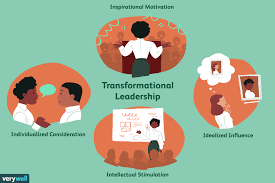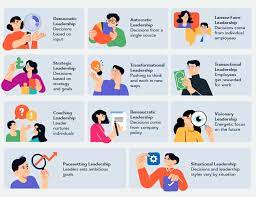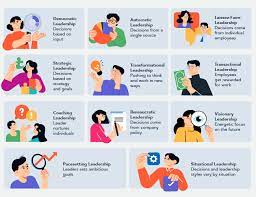10 Tips to Transform the Leadership Style at Your Organization
There is no one right way to lead an organization, but there are many ways to achieve success. One popular approach is 360° leadership. This style involves taking a holistic view of an organization’s operations and making decisions based on all the data available. It’s a powerful tool for creating change and driving innovation. Here are 10 tips for transforming your leadership style into 360° form:
1. Start by understanding your organization from all angles. Get to know its history, its strengths and weaknesses, and what makes it unique. This will help you make informed decisions about how to best use resources and grow the business forwards.
2. Build teams that complement each other’s strengths. For example, don’t put together a team of engineers who don’t have marketing skills or vice versa. Balance your team members’ skills so they can work together as a cohesive unit.
3. Be open to feedback from all levels of the organization. Understand what people want and need from their leaders, and then give it to them in an open and transparent manner. This will help ensure that everyone feels heard and understood, which leads to collaboration and improved performance overall.
4. Communicate with employees regularly – even when you don’t have anything new to share! Regular communication lets everyone know where you stand on important issues, allows for constructive criticism when necessary, and builds trust between leader and followers alike.” “5.. In order to stay ahead of the curve, be constantly learning new things
emotional intelligence and leadership
1. Understand your own emotional intelligence. Leaders with high emotional intelligence are better at relating to other people and can build trust and cooperation.
2. Be aware of the emotions of others. Leaders who are emotionally intelligent know how to read others’ emotions and respond in a way that builds trust and cooperation.
3. Practice active listening. Leaders who are good at listening actively pay attention to what others are saying, not just what they are saying themselves. This helps build trust and cooperation.
4. Don’t rush decisions. When making decisions, leaders who are good at managing their emotions take the time to consider all the information available before making a decision. This helps build trust and cooperation.
5. Set clear goals and objectives. Leaders who are good at managing their emotions set clear goals and objectives for their team and make sure everyone is on the same page regarding these goals. This leads to greater trust and cooperation among team members.
6. Communicate clearly and concisely. When communicating with team members, leaders who are good at managing their emotions communicate in a clear, concise manner so everyone understands what is being said and why it is important.
7. Encourage team participation and collaboration. Leaders who are good at managing their emotions encourage team participation and collaboration by providing positive reinforcement when teammates contribute positively to the organization’s goals.
8. Provide feedback effectively . Leaders who are good at managing their emotions provide feedback that
Start by recognizing that leadership and emotional intelligence are both key components of an effective organization.
Leadership is the ability to motivate and inspire others to achieve common goals. Emotional intelligence is the ability to effectively manage emotions, both our own and those of others.
Both leadership and emotional intelligence require an understanding of human behavior. Leaders must be able to understand what motivates people and how they react to various situations. They must also be able to communicate effectively, which requires an understanding of how people process information and respond to it.
Emotional intelligence is just as important as leadership in creating a successful organization. Individuals who are emotionally intelligent are able to create positive relationships, resolve conflict effectively, and manage stress in a healthy way.
An organization that values both leadership and emotional intelligence will be more successful than one that only focuses on one or the other. Both are essential components of an effective team or organization.
Make sure to create an environment that fosters both the growth and development of employees, as well as their emotional intelligence.
One way to do this is by ensuring that communication is open and honest between employees and management. Encourage employees to share their ideas, concerns, and suggestions with you, and let them know that their input is valued. Additionally, create a system where employees feel comfortable approaching you with problems or conflicts they’re experiencing.
It’s also important to provide opportunities for employees to grow and develop their skills. Offer training and development programs that allow employees to improve their knowledge and capabilities. And make sure to give employees the opportunity to put their new skills into practice by providing meaningful work assignments.
Finally, take the time to get to know your employees on a personal level. Showing genuine interest in their lives outside of work can help build trust and foster a more positive relationship. When your employees feel like you care about them as people, they’ll be more motivated to do their best work for you.
Take the time to get to know your employees on a personal level and learn their strengths and weaknesses.
Too often, managers focus on an employee’s weaknesses and try to correct them. While it’s important to be aware of areas that need improvement, it’s just as important to recognize an employee’s strengths. When you take the time to get to know your employees on a personal level, you can learn about their strengths and weaknesses. This knowledge will help you manage them more effectively and help them reach their full potential.
Use your emotional intelligence skills in order to motivate and inspire your team.
When you can read and understand the emotions of those around you, it puts you in a much better position to motivate them. If you can see that someone is feeling down or frustrated, you can do something to help pick them up. And when people are feeling good, you can capitalize on that by asking for their help in getting things done.
In order to be an effective leader, it’s important to be attuned to the emotional states of those under your charge. By doing so, you can more easily figure out what will inspire and motivate them. When everyone is working together towards a common goal, greatness can be achieved.
Be open to feedback and be willing to change your leadership style based on what works best for your team.
As a leader, one of the most important things you can do is be open to feedback. This means being willing to listen to what others have to say about your performance and then making changes accordingly. It can be difficult to hear criticism, but it’s essential if you want to be an effective leader.
Your leadership style should also be flexible based on the needs of your team. If something isn’t working, don’t be afraid to change it up. The goal is to find what works best for your group so that you can all achieve success together.
Be patient and allow your team time to develop trust in you.
If you’re the leader of a team, it’s important to be patient and allow your team time to develop trust in you. Trust is essential for any team to function effectively, and it takes time to build. If you’re patient and give your team the time they need to trust you, you’ll eventually have a strong, cohesive group that can accomplish great things together.
Remember that success does not come overnight, it takes time and effort to be a successful leader.

True success as a leader takes time, dedication and hard work. It doesn’t happen overnight. Anyone can be a leader, but not everyone can be a successful one. To achieve true success, you need to have a clear vision for your team or organization, and the ability to inspire others to work together towards common goals. You also need to be able to make tough decisions and stand by them even when things get difficult. Finally, you must always be learning and growing as a leader so that you can continue to meet the challenges of today and tomorrow head on.
Always put the safety of your employees first, no matter what obstacles arise.
If you prioritize the safety of your employees, you will find that other obstacles will become much easier to overcome. Your employees are the backbone of your company, and if they aren’t safe, nothing else matters. Make sure you have a comprehensive safety plan in place, and that everyone is aware of it. Review it regularly and update it as necessary.
Stay humble – Leadership is not about being perfect, it’s about helping others reach their potential.
Be coachable – Take feedback from others seriously and use it to improve your own performance.
Encourage others – Help those around you to reach their goals and be the best they can be.
Create a positive environment – Surround yourself with people who support your vision and who share your values.
Make things happen – Be decisive and take action to make things happen. Don’t wait for someone else to do it for you.
1Remember that leadership is a journey, not a destination
. The best leaders are always learning and growing. They never stop trying to improve themselves and their teams.
2As a leader, you must be willing to put in the hard work required to achieve success. You can’t expect others to do the work for you. Leaders who are unwilling to work hard are usually not very successful.
3One of the most important aspects of being a leader is setting an example for others to follow. If you want your team to be successful, you need to show them what it takes to succeed. Lead by example and set the standard for your team.
4It’s also important to have a vision for your team or organization. Without a vision, it’s difficult to know where you’re going or what you want to achieve. As a leader, it’s up to you to develop a clear vision and then communicate it effectively so that everyone is on the same page.
5Finally, remember that leadership is all about people. The best leaders are those who care about others and understand how to motivate and inspire them. Great leaders build strong relationships with their team members and make them feel like they’re part of something bigger than
leadership in rome
1. Start by assessing the current leadership style at your organization. This can be done through surveys or interviews with employees.
2. Evaluate whether the current leadership style is effective and productive. Is it motivating and inspiring employees? Do they feel a sense of ownership in their work?
3. Implement a new leadership style that is more effective and productive. This may involve changing the structure and hierarchy of the organization, creating new roles and responsibilities, or emphasizing teamwork over individual achievement.
4. Encourage employee participation in the development of the new leadership style. This will help to ensure that it is embraced and effective at achieving company goals.
5. Celebrate successes along the way, both individual and collective. This will reinforce the new leadership style and encourage employees to continue working hard in support of the organization’s goals.
6. Dismiss any negative behavior or attitudes quickly and firmly, without allowing them to fester or become entrenched within the organization.
7. Reward employees for their efforts and contributions, both individual and collective, throughout the implementation of the new leadership style. This will help to motivate them to continue working hard in support of the organization’s goals.
8. Take steps to address any perceived challenges or obstacles that may arise during implementation of the new leadership style, such as resistance from certain employees or departmental leaders, budgetary constraints, or changes in business conditions.
9. Stay open and communicative with employees throughout the






